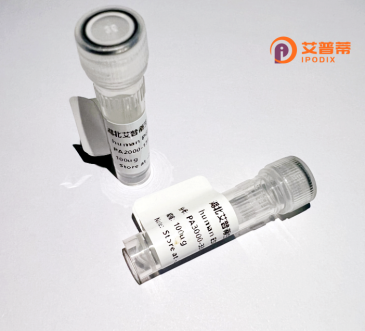
| 纯度 | >90%SDS-PAGE. |
| 种属 | Human |
| 靶点 | STAP2 |
| Uniprot No | Q9UGK3 |
| 内毒素 | < 0.01EU/μg |
| 表达宿主 | E.coli |
| 表达区间 | 1-403 aa |
| 活性数据 | MASALRPPRV PKPKGVLPSH YYESFLEKKG PCDRDYKKFW AGLQGLTIYF YNSNRDFQHV EKLNLGAFEK LTDEIPWGSS RDPGTHFSLI LRDQEIKFKV ETLECREMWK GFILTVVELR VPTDLTLLPG HLYMMSEVLA KEEARRALET PSCFLKVSRL EAQLLLERYP ECGNLLLRPS GDGADGVSVT TRQMHNGTHV VRHYKVKREG PKYVIDVEQP FSCTSLDAVV NYFVSHTKKA LVPFLLDEDY EKVLGYVEAD KENGENVWVA PSAPGPGPAP CTGGPKPLSP ASSQDKLPPL PPLPNQEENY VTPIGDGPAV DYENQDVASS SWPVILKPKK LPKPPAKLPK PPVGPKPEPK VFNGGLGRKL PVSSAQPLFP TAGLADMTAE LQKKLEKRRA LEH |
| 分子量 | 44.8 kDa |
| 蛋白标签 | His tag N-Terminus |
| 缓冲液 | PBS, pH7.4, containing 0.01% SKL, 1mM DTT, 5% Trehalose and Proclin300. |
| 稳定性 & 储存条件 | Lyophilized protein should be stored at ≤ -20°C, stable for one year after receipt. Reconstituted protein solution can be stored at 2-8°C for 2-7 days. Aliquots of reconstituted samples are stable at ≤ -20°C for 3 months. |
| 复溶 | Always centrifuge tubes before opening.Do not mix by vortex or pipetting. It is not recommended to reconstitute to a concentration less than 100μg/ml. Dissolve the lyophilized protein in distilled water. Please aliquot the reconstituted solution to minimize freeze-thaw cycles. |
以下是关于重组人STAP2蛋白的3条参考文献摘要示例:
1. **文献名称**: *STAP-2 modulates TCR-mediated signaling and immune response*
**作者**: Sekine Y, et al.
**摘要**: 研究揭示了STAP2通过调节T细胞受体(TCR)信号通路中的蛋白激酶(如Lck)活性,影响T细胞活化和免疫应答的机制。实验利用重组STAP2蛋白验证其与Lck的相互作用,表明STAP2缺失会导致T细胞功能异常。
2. **文献名称**: *Structural insights into STAP2 as a regulator of STAT signaling*
**作者**: Tanaka M, et al.
**摘要**: 通过重组STAP2蛋白的晶体结构解析,阐明了其与STAT3蛋白结合的结构域及功能界面。研究提出STAP2通过招募STAT3至细胞膜微区,增强细胞因子信号传导的分子机制。
3. **文献名称**: *STAP2 promotes leukemia cell proliferation via ERK pathway activation*
**作者**: Yamamoto T, et al.
**摘要**: 发现在白血病细胞中,STAP2通过激活ERK信号通路促进细胞增殖。重组STAP2蛋白的过表达实验证实其通过结合c-Kit受体下游分子驱动肿瘤生长,提示其作为白血病潜在治疗靶点。
*注:以上为模拟示例,建议通过PubMed或Google Scholar检索最新文献获取详细信息。*
STAP2 (Signal-transducing adaptor protein 2) is a member of the STAP adaptor protein family, characterized by its role in modulating intracellular signaling pathways. It contains functional domains, including a pleckstrin homology (PH) domain and a Src homology 2 (SH2) domain, enabling interactions with phosphorylated tyrosine residues and membrane components. Primarily expressed in immune cells, STAP2 acts as a scaffold to facilitate cross-talk between signaling cascades, particularly those involving cytokine receptors, immune checkpoints, and growth factor receptors.
STAP2 is implicated in regulating immune and inflammatory responses. Studies highlight its involvement in JAK-STAT, NF-κB, and MAPK pathways, where it influences transcriptional activation of genes linked to cell proliferation, differentiation, and apoptosis. For example, STAP2 interacts with STAT3 to enhance its phosphorylation and nuclear translocation, amplifying pro-inflammatory signaling. Dysregulation of STAP2 has been associated with pathological conditions, including cancers (e.g., breast cancer, leukemia), autoimmune disorders, and metabolic syndromes. Overexpression of STAP2 in certain tumors correlates with enhanced cell survival and therapy resistance, suggesting oncogenic potential.
Recent research explores STAP2’s dual roles in immune regulation and tumorigenesis, though its mechanistic nuances remain incompletely understood. Targeting STAP2 or its associated pathways may offer therapeutic strategies for immune-related diseases and cancer. However, challenges persist in deciphering its tissue-specific functions and post-translational modifications. Further investigations are needed to clarify its physiological relevance and translational applications.
×